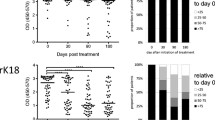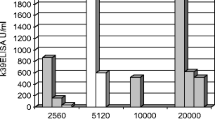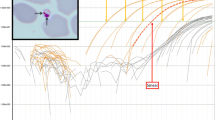Abstract
In an endemic area of visceral leishmaniasis (VL), individuals with leishmanial antibodies that reacted in the radioimmunoassay (RIA) were retested to determine duration of leishmanial antibody retention. One fourth of adults retained antibodies for at least 10 months. At least 2/3 of asymptomatic children retained leishmanial antibodies for 5 to 7 months after detection. 2/3 of children treated for VL retained leishmanial antibodies for 5 to 7 months after treatment, while 1/3 retained antibodies for over a year. These data modify conclusions that can be drawn from a single serosurvey. Since leishmanial RIA antibodies can persist in humans for at least two transmission seasons, incidence estimates require serial serosurveys.
Similar content being viewed by others
References
Azab M.E., Rifaat M.A., Schnur L.F., Makhlouf S.A., ElSherif E., Salem A.M. (1984): Canine and rodent leishmanial isolates from Egypt. Trans. Roy. Soc. Trop. Med. Hyg., 78: 263–264
Badaro R., Jones T.C., Carvalho E.M., Sampaio D., Reed S.G., Barral A., Teixeira R., Johnson W.D. Jr. (1986): New perspectives on a subclinical form of visceral leishmaniasis. J. Infect. Dis., 154: 1003–1011.
Beier J.C., ElSawaf B.M., Morsy T.A., Merdan A.I., Rifaat M.M., ElSaid S.M. (1986): Sandflies (Diptera: Psychodidae) associated with visceral leishmaniasis in El Agamy, Alexandria Governorate, Egypt. J. Med. Entomol., 23: 616–621.
Faris R., Massoud A., Kassem A., Feinsod F.M., ElSaid S., Youssef F.C., Amer M., Gadallah M., Saah A.J. (1986): Indigenously acquired human visceral leishmaniasis in El Agamy (Alexandria Governorate) Egypt. Ann. soc. Belge Med. Trop., 66: 325–329.
Faris R., Feinsod F.M., Londner M.Y., Massoud A., Rosen G., Ei Said S., Gadallah M.A., Saah A.J. (In press). Ann. Trop. Med. Parasitol. The epidemiology of human visceral leishmaniasis in El Agamy (Alexandria Governorate), Egypt — Serosurvey and case/control study.
Feinsod F.M., Faris R., Londner M. V., Rosen G., El Said S.M., Karim M.A., Saah A.J. (In press). Immunosuppressive medication associated with leishmanial antibodies in adults residing in an endemic focus of infantile visceral leishmaniasis. A case/control study. Ann. Trop. Med. Parasitol.
Jahan A., Diesfeld H.J. (1983): Evaluation of a visually read ELISA for serodiagnosis and seroepidemiological studies of kala-azar in the Baringo District, Kenya. Trans. Roy. Soc. Trop. Med. Hyg., 4: 451–454.
Londner M. V.,Frankenburg S.,Slutzky G.M., Greenblatt C.L. (1983): Action of leishmanial excreted factor (EF) on human lymphocyte blast transformation. Parasite Immunol., 5: 249–256.
Lowry O.H., Rosebrough N.J., Farr A.L., Randall R.J. (1951): Protein measurment with the Folin phenol reagent. J. Biol. Chem., 193: 265–275.
Mansour N.S., Awadalla H.N., Youssef F. G., Tewfik S. (1984): Characterization of Leishmania isolates from children with visceral infections contracted in Alexandria, Egypt. Trans. Roy. Soc. Trop. Med. Hyg., 78: 704.
Mathews H. (1981): Parastitic Disease: Testing with filter-paper blood spots. Laborat. Manag., 19: 55–62.
Morsy T.A., Michael S.A., Feinsod F.M., Rifaat M.A. (1984): Canine reservoir for visceral leishmaniasis in El Agamy (Alexandria) Egypt. J. Egypt. Soc. Parasitol., 13: 51–55.
Morsy T.A., Schnur L.F., Feinsod F.M., Salem A.M., Wahba M.M., ElSaid S.M. (1987): Natural infections of Leishmania major in domestic dogs from Alexandria, Egypt. Am. J. Trop. Med. Hyg., 37: 49–52.
Pampiglione S., Manson-Bahr P.E.C., Giungi F, Giunti G., Parenti A., Trotti G. (1974). Studies on Mediterranean leishmaniasis. Asymptomatic cases of visceral leishmaniasis. Trans. R. Soc. Trop. Med. Hyg., 68: 447–53.
Rosen G., Londner M. Y., Greenblatt C.L., Morsy T.A., El-On J. (1986): Leishmania major: solid phase radioimmunoassay for antibody detection in human cutaneous leishmaniasis. Exp. Parasitol., 62: 79–84.
ElSawaf B.M., Beier J. C., Hussein S.M., Kassem H.A., Satter S.A. (1984): Phlebotomus langeroni: a potential vector of kala-azar in the Arab Republic of Egypt. Trans. Roy. Soc. Trop. Med. Hyg., 78: 421.
Tewfik S., Kassem S.A., Aref M.K., Awadalla H.N., Abadir A. (1983): A preliminary report on two cases of visceral leishmaniasis in Egypt. Trans. Roy. Soc. Trop. Med. Hyg., 77: 334–335.
Author information
Authors and Affiliations
Rights and permissions
About this article
Cite this article
Londner, M.V., Feinsod, F.M., Faris, R. et al. Persistence of human leishmanial antibodies in an endemic area of visceral leishmaniasis in El Agamy, Egypt. Eur J Epidemiol 4, 473–476 (1988). https://doi.org/10.1007/BF00146401
Issue Date:
DOI: https://doi.org/10.1007/BF00146401




